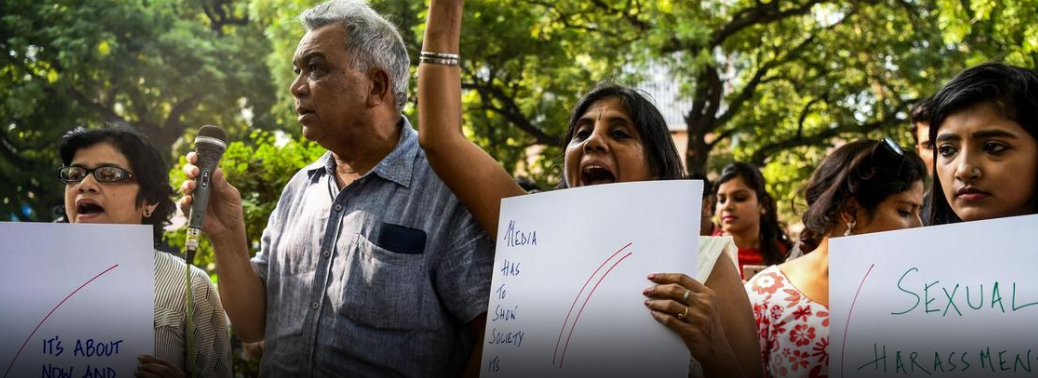Panel to study Issues raised by #METOOINDIA
24, Oct 2018

Prelims level :
Mains level : G.S-II Welfare schemes for vulnerable sections of the population by the Centre
Why in News?
- The government will set up a committee of judges and lawyers to examine the existing legal and institutional framework to deal with complaints of sexual harassment at the workplace, Minister for Women and Child Development Menaka Gandhi.
#Me too Movement:
- The global outrage over the Harvey Weinstein incident in the West, where the noted Hollywood producer was accused of sexual harassment by over 70 women, the #MeToo movement has finally arrived in India, engulfing the whole media and entertainment industry.
- Several women have bravely come out with stories about harassment and sexual abuse at workplace at the hands of the powerful and higher-ups.
- The #MeToo movement, which began as a hashtag on Twitter in 2017 amid the Weinstein incident, has now become a global phenomenon.
- Created by Alyssa Milano, the movement soon found support with noted Hollywood actors Gwyneth Paltrow, Ashley Judd, Jennifer Lawrence, and Uma Thurman.
- The movement was chosen as the Person of the Year by the Time magazine. It also gave birth to the more militant Time’s Up campaign.
What are Vishaka guidelines and what do they say?
- The guidelines date back to 1997 when the Supreme Court laid them down while passing judgment in a public interest litigation filed by Vishaka and other women’s rights groups over the infamous Bhanwari Devi gangrape case. Bhanwari Devi, a social worker from Rajasthan had in 1992 prevented the marriage of a one-year-old girl, inviting wrath of the villagers. The gangrape was allegedly an act of revenge.
- Hearing the PIL, the apex court took note of the fact that the civil and penal laws of the time did not adequately provide for specific protection of women from sexual harassment at workplaces, and made it legally binding for employers to observe some guidelines to ensure prevention of sexual harassment of women.
- Prohibition, prevention, redress — these were the three key obligations that were imposed on institutions as the guidelines defined sexual harassment at workplaces. The Supreme Court said every organisation must set up an internal complaints committee or ICC to look into matters of sexual harassment of women at the workplace.
What is the law that currently governs sexual harassment at workplace?
- In 2013, the Sexual Harassment of Women at Workplace (Prevention, Prohibition and Redressal) Act was passed broadening the Vishaka guidelines. Defining sexual harassment in clearer terms, the new law laid down the procedures for complaint and inquiry, and the action to be taken.
- The Act mandates that every organisation with 10 or more employees set up an internal complaints committee of ICC at each office or branch. It defines various aspects of sexual harassment and protects all women working at, or even visiting, a workplace, in any capacity. The Act defines as “victim” any woman “of any age whether employed or not”, who alleges to have been “subjected to any act of sexual harassment”.
What constitutes sexual harassment at workplace?
- The Vishaka guidelines define as sexual harassment any unwelcome sexually determined behaviour (whether directly or by implication). These are:
- Physical contact and advances
- A demand or request for sexual favours
- Sexually coloured remarks
- Showing pornography
- Any other unwelcome physical, verbal or non-verbal conduct of sexual nature With the 2013 law broadening these guidelines, the Ministry of Women & Child Development has published a Handbook on Sexual Harassment of Women at Workplace Act. The handbook has detailed instances of unwelcome behaviour that constitutes sexual harassment at the workplace. These can be, broadly:
- Sexually suggestive remarks or innuendos; serious or repeated offensive remarks; inappropriate questions or remarks about a person’s sex life
- Display of sexist or offensive pictures, posters, MMS, SMS, WhatsApp, or emails
- Intimidation, threats, blackmail around sexual favours; also, threats, intimidation or retaliation against an employee who speaks up about these
- Unwelcome social invitations with sexual overtones, commonly seen as flirting
- Unwelcome sexual advances
- According to the handbook, “unwelcome behaviour” is experienced when the victim feels bad or powerless; it causes anger/sadness or negative self-esteem. It adds unwelcome behaviour is one which is “illegal, demeaning, invading, one-sided and power based”.
- The Act specifies five circumstances that amount to sexual harassment. These are:
- Implied or explicit promise of preferential treatment in her employment
- Implied or explicit threat of detrimental treatment
- Implied or explicit threat about her present or future employment status
- Interference with her work or creating an offensive or hostile work environment
- Humiliating treatment likely to affect her health or safety.






